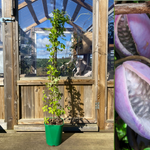Subscribe and save 10%!

Five-leaved Akebia 80-100 cm (Akebia quinata)
340 SEK
Unit price perOut of stock
Share
340 SEK
Unit price per1st plant Five-leaf Akebia: 2 years old - current height: 80-100 cm
All plants are ready to bloom and set fruit.
Common Name : Five-leaf Akebia, Chocolate Vine
Scientific name : Akebia quinata
Family : Lardizabalaceae
Plant history & use :
The Five-leaf Akebian originates from Japan, China and Korea where it is often found naturally growing on mountain slopes and on hills against hedges, tree trunks, along forest edges and watercourses.
The highlight of this akebia is its oblong, edible, purple fruits that form inside pods that open up on their own when ripe. The seeds are surrounded by a juicy flesh that is sweet to the taste - it is said to be reminiscent of the flesh of dragon fruit. In Japan, it is eaten mainly as a seasonal delicacy. The fruit is sometimes eaten with lemon to enhance the taste.
The shell of the pod is used in cooking, where it is filled with minced meat and then fried.
The seeds are bitter and should not be chewed, however, they can be swallowed whole or simply spit out to avoid the bitter taste.
The fruits can be made into jam, jelly, juice or smoothies and even ice cream can be made from the pulp.
Young shoots can be added to salads. Leaves can be dried and made into tea.
Often used as a ground cover plant: along walls, fences, fields and other less attractive surfaces.
Akebian is also often used as a soil binder on slopes to prevent erosion.
The Five-Leaf Akebian gives the garden an oriental look.
The flowers are said to have scents ranging from vanilla to honey and chocolate. The flowers are visually clearly divided into male and female flowers.
Studies have shown that consuming Akebia quinata reduces fat accumulation in the body and lowers blood cholesterol levels, and thus may be effective in combating obesity. This is a relatively new finding (2022) and theories are being floated that this fruit could become more well-known in the near future.
The same study has also shown that A. quinata has a cleansing effect on the liver, kidneys and cardiovascular system. Regular consumption could have led to improved health. A. quinata is diuretic.
When consumed, the plant is also said to be an inhibitor against bacterial and fungal infections. The roots act as a fever reducer.
In traditional Chinese medicine, akebian is used to treat urinary tract infections, insufficient lactation, and rheumatoid arthritis.
The vines are also used to weave baskets.
An oil is extracted from the seeds and is used in traditional Chinese soap making.
Cultivation :
Grows best in a sunny location, although tolerant of shady locations. Prefers slightly sandier soils with good drainage and good moisture retention properties. A humus-rich, slightly sandy soil is best - such as potting soil mixed with sand. Can grow in soils with both higher and lower pH values.
Likes regular watering. However, it is relatively resistant to drought. Also very cold-resistant - can withstand lower temperatures between -20ºC and -30ºC.
Generally fast growing. Can be pruned in early spring if necessary.
Akebia are not self-pollinating, which means that all plants in the genus need another individual that is genetically different to be successfully pollinated and produce fruit - it doesn't have to be a different species/variety, just a different individual.
Features :
Year: Perennial
Growing position: sun / partial shade
Height: up to 4 m
Growing zone: 1-3
- Choosing a selection results in a full page refresh.
- Opens in a new window.
























